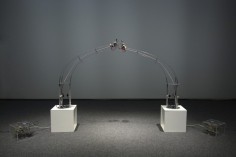Carolin Liebl & Nikolas Schmid-Pfähler
Vincent and Emily
source: fastcompanycn
机器人具备了人类的思维和感情后,成了反攻人类的最大敌人——这是不少电影的主题。如今,机器人真的开始培养情绪了。
文森特和艾米丽是对夫妻,我们每个人身边都应该有这么一对夫妻,似乎他们每天都吵架。但他们的关系与其他吵吵闹闹的夫妻关系有点不同。文森特和艾米丽不是靠文字和肉体相连,而是通过电线和传感器。他们是机器人。
让我们称之为机器人之恋吧。一个新的项目让两个非人的事物应对最具人类特色的情感。但并不总是有好结果。
德国艺术家尼古拉斯•斯密德•帕赫勒(Nikolas Schmid-Pfähler)和凯罗琳•利布尔(Carolin Liebl)创造了这两个机器人,它们通过感应器识别对方以及观众的声音和动作信息,并据此通过齿轮和马达做出反应,表现特定的情感。
该项目在画廊面向访客展出,目的在于通过最为简单的形态塑造人类夫妻的典范。机器人简单的线条代表人的身体。机器人根据他人的言行做出反应,取代人类复杂的决策。这两夫妻协调着它们之间的夫妻关系以及它们与社会的关系。
用两位艺术家的话来说,“我们预先设定程序,使得两位机器人发生冲突。”他们解释说:“就像任何一对夫妻一样,总会有发生误会的时候:如果文森特通过上上下下的运动发送积极信号,艾米丽也有可能将这些信号理解为消极信号。”结果就是艾米丽会做出古怪动作,就好像两人发生严重冲突,非常生气一样。
两个机器人的关系怎样全由观众定夺,观众可能本能地会将两者关系与我们所说的简单戏剧相连。如今我们越来越意识到人工智能正飞速发展并会对社会带来影响,这让我们越来越不安,在这一背景下探索我们投资于机器人的意义是个明智之举。更加智能化、功能更强的机器人将会代替我们工作,但是他们永远无法拥有人类的情商,永远无法应对复杂的人际关系。
文森特和艾米丽好像在问:如果机器人可以像相爱的人一样吵架,那会不会有一天机器人可以像人类一样相爱?
.
.
.
.
.
.
.
source: fileorgbr
Abstract:
O amor na era da automação: Dois robôs dotados de vontade própria estão em um conflito bizarro entre si e com tudo que os cerca. “Vincent and Emily” mostra ao espectador a solidão de um relacionamento amoroso e simultaneamente o envolvimento dos parceiros na sociedade e seus impulsos. Assim como nas relações humanas, as duas criaturas se defendem e têm de traçar um limite em relação ao exterior.
Humanos só conseguem exprimir seus sentimentos e emoções verbalmente e através de suas ações, e para isso os dois robôs dependem de seus motores. Ambos captam sons e movimentos por meio de sensores e reagem a esses sinais com expressões. Assim como em uma relação humana, isso gera equívocos: Se Vincent envia sinais positivos com movimentos para cima e para baixo, é possível que Emily interprete-os como sinais negativos. A discórdia é pré-programada.
A interação imprevisível entre Vincent e Emily, causada por seu relacionamento tenso, leva o espectador a fazer projeções individuais. Intuitivamente, ele irá procurar semelhanças com certos padrões de comportamento humano.
O movimento dos robôs é controlado por um sistema formado por três motores cuja rotação é transformada em um movimento linear por meio de rodas e racks de transmissão. Devido à elasticidade dos eixos metálicos móveis, as ações do casal ficam mais uniformes e, ao mesmo tempo, cada vez mais imprevisíveis, o que resulta em mais impulsos próprios e na leveza e facilidade de suas interações.
Biography:
Carolin Liebl: nascida em 1989 em Lichtenfels, Alemanha, mora em Frankfurt e desde 2010 estuda comunicação visual, com foco em arte eletrônica, na Universidade de Arte e Design de Offenbach.
Nikolas Schmid-Pfähler: nascido em 1987 em Gießen, Alemanha, mora em Frankfurt e desde 2009 estuda comunicação visual, com foco em arte eletrônica, na Universidade de Arte e Design de Offenbach.
As exposições de ambos em 2013 incluem o Toolkit Festival (Veneza, Itália), a WRO-Biennale (Wroclaw, Polônia), EMAF (Osnabrück, Alemanha), B-Seite (Mannheim, Alemanha) e Uamo (Munich, Alemanha), entre outras.
.
.
.
.
.
.
.
source: fileorgbr
Love in the automation age: Two self-willed robots are in a bizarre conflict between each other and their surroundings. “Vincent and Emily” show the viewer the solitude of a partner relationship and simultaneously the involvement of the partners in society and their impulses. Analogue to human relationships, the two creatures stand for themselves and have to draw the line towards the outside.
As humans are only able to communicate their thoughts and emotions verbally and through their actions, likewise the two robots depend on their motors. The two technical creatures capture sounds and movements via sensors and react to those signals with expressions. Just like in each human relationship, it comes to misunderstandings: If Vincent sends positive signals by up and down movements, it is possible that Emily interprets even those signals as negative. Disagreement is preprogrammed.
The unpredictable interaction and interplay between Vincent and Emily, caused by their tense relationship, trigger the viewer’s individual projections. Intuitively he will be searching for the similarities to particular patterns of human behavior.
The movement of the robots is controlled by a pulling system, consisting of three motors whose rotation is transformed into a linear motion via gear wheels and gear racks. Due to the elasticity of the moving metal shafts, the actions of the couple become at the same time smoother and increasingly unpredictable, which results in an additional momentum of its own and a lightness and ease within their interactions.
Biography:
Carolin Liebl: born in 1989 in Lichtenfels, Germany, lives in Frankfurt and studies visual communications with focus on media art at the Offenbach University of Art and Design since 2010.
Nikolas Schmid-Pfähler: born in 1987 in Gießen, Germany, lives in Frankfurt and studies visual communications with focus on media art at the Offenbach University of Art and Design since 2009.
Some exhibitions of both in 2013 include Toolkit Festival (Venice, Italy), WRO-Biennale (Wroclaw, Poland), EMAF (Osnabrück, Germany), B-Seite (Mannheim, Germany) and Uamo (Munich, Germany), among others.
.
.
.
.
.
.
.
source: creativeapplicationsnet
Created by Nikolas Schmid-Pfähler and Carolin Liebl, Vincent & Emily are two self-willed robots who are in a bizarre conflict between each other and their surroundings. The robots are designed to explore solitude of a partner relationship and their impulses. Mimicking humans, using sounds and gestures, the robots have speakers motions controlled by their motors. In addition, the creatures capture sounds and movements via sensors and react on those signals with own expressions.
Just like in each human relationship it comes to misunderstandings: If Vincent sends positive signals by up and down movements, it is possible that Emily interprets even those signals as negative. Disagreement is preprogrammed. The unpredictable interaction and interplay between Vincent and Emily, caused by their tense relationship, trigger the viewer’s individual projections. Intuitively he will be searching for similarities to particular patterns of human behavior.
The movement of the robots is realized by a pulling system, consisting of three motors whose rotation is transformed into a linear motion via gear wheels and gear racks. Due to the elasticity of the moving metal shafts, the actions of the couple become at the same time smoother and increasingly unpredictable, which results in an additional momentum of its own and a lightness and ease within their interactions.


